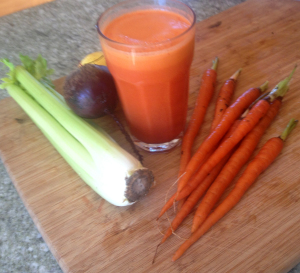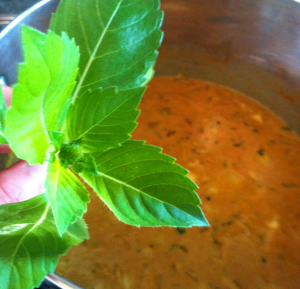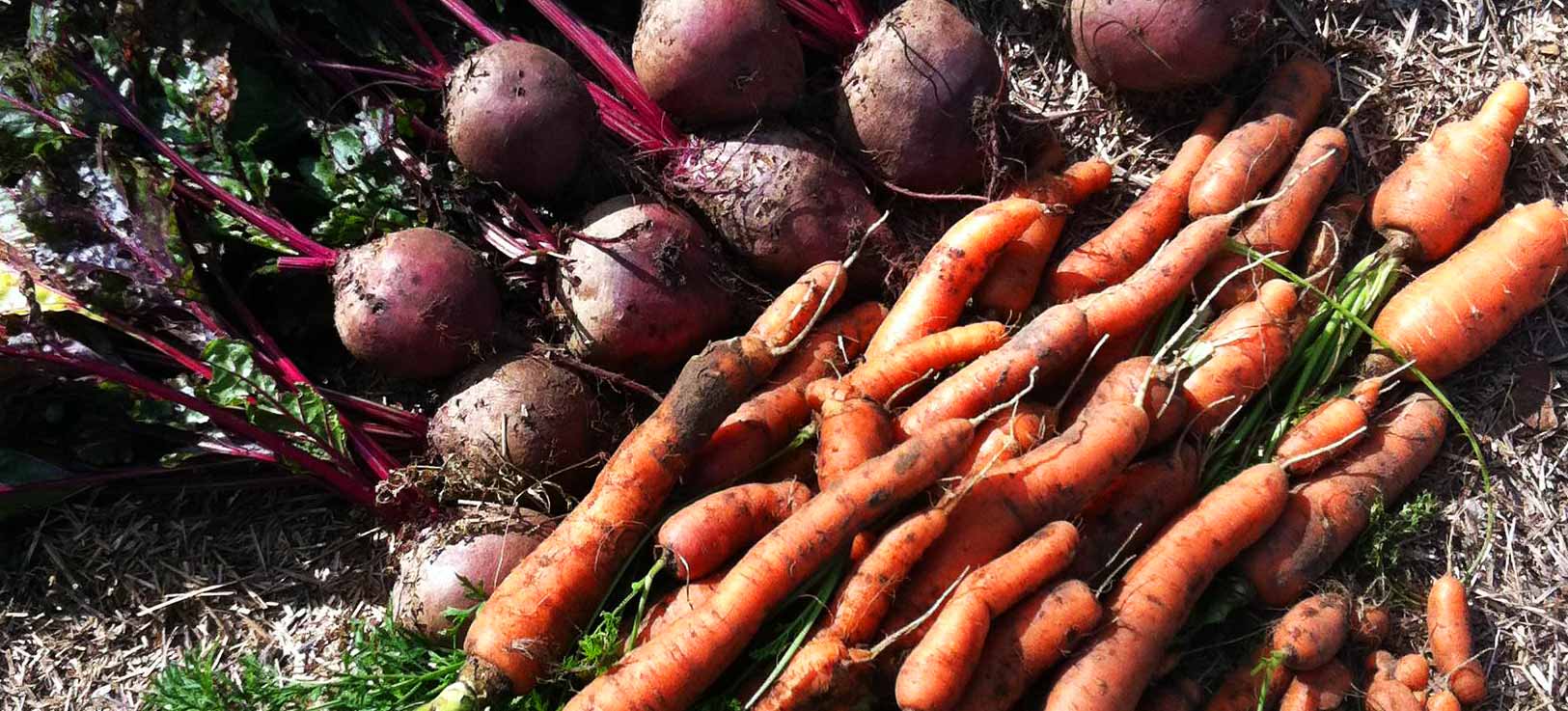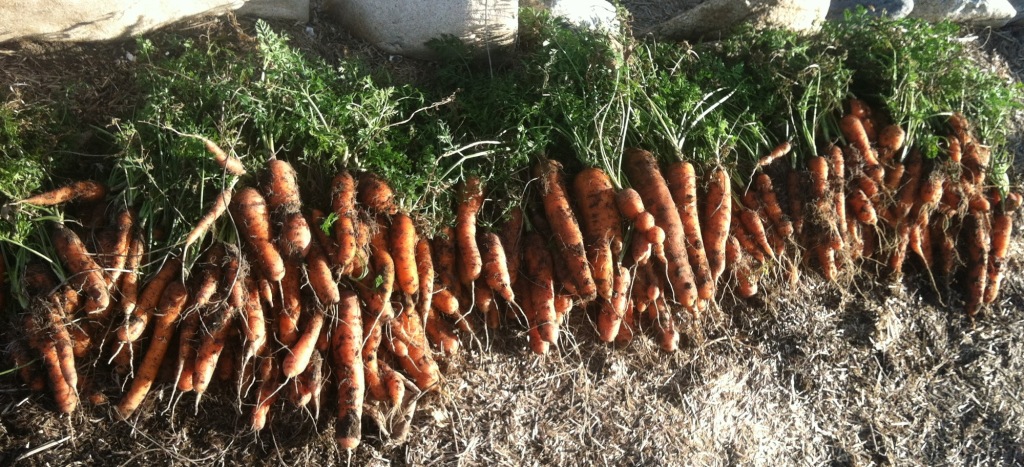From The Garden – Food is Medicine – Carrots
From the Garden – Food is Medicine
I love carrots, I grow them every year and right now I am harvesting them and will be for the next few weeks. I am grateful that here on Block Island in November, my garden is still providing food. There really is nothing like being out in the crisp, salt air as the sun sets harvesting for dinner.
Carrots are my favorite in salads, they are great in soups and I have a new love for carrot juice since I got an awesome juicer. I often fortify myself with fresh carrot, beet and lemon juice. Another great treat is eating a carrot from the garden slathered with nut butter (I have a weakness for crunchy peanut butter, but almond butter is so much better for you). Many of you from our Labor Day gatherings in the Catskill Mountains, know I make a bangin’ Coconut curry carrot soup☺. Carrots are a beneficial food for the body full of many vital nutrients and enzymes. In this month’s From The Garden, I have laid out some helpful tips on how to grow them, eat them and what they are used for.
Planting & Harvesting:
 Carrot seeds are sown in the early spring and harvested in the summer through the fall. Seeds can be sown after the last chance of frost. They grow best in loose, well-drained, slightly sandy soil. Plant in rows 8 inches apart, with seed spacing of ½ inch apart in the row. Cover lightly with soil and press down. Keep soil moist until germination. Carrot is very slow to germinate – normally requiring 3-4 weeks (depending on the soil and weather conditions). Carrots like full sun, but will tolerate partial shade. When plants are 2-3 inches tall, thin to 2-3 inches apart so that each little plant has enough room to grow to maturity. Carrots mature and are ready to harvest 2 1/2 – 4 months depending on variety and conditions.
Carrot seeds are sown in the early spring and harvested in the summer through the fall. Seeds can be sown after the last chance of frost. They grow best in loose, well-drained, slightly sandy soil. Plant in rows 8 inches apart, with seed spacing of ½ inch apart in the row. Cover lightly with soil and press down. Keep soil moist until germination. Carrot is very slow to germinate – normally requiring 3-4 weeks (depending on the soil and weather conditions). Carrots like full sun, but will tolerate partial shade. When plants are 2-3 inches tall, thin to 2-3 inches apart so that each little plant has enough room to grow to maturity. Carrots mature and are ready to harvest 2 1/2 – 4 months depending on variety and conditions.
Carrots are long lasting in a root cellar or in the crisper of your fridge, as long as they are dry. Yes it is better to eat them freshly picked, but they also are great to store for the winter.
My garden is my sanctuary and I am blessed to be able to grow my own food and medicine. When it is time to prep the soil to sow the seeds I give thanks and love to Mother Earth, for these seeds are planted within her body. From sowing to germination to watching them grow into healthy bushels of deliciousness, I talk to them with love and excitement. When it is time for harvest, I give thanks to the mother and with care I pull them from the earth. I believe, You are what you eat. So all the love and intention I share throughout the months of growing, is then going right back into me as nutrition and medicine.
The Power of Carrot Juice:
 Raw carrot juice is one of the best overall therapeutic foods. It alkalizes, cleanses, nourishes and stimulates almost every system in the body. There are six major functional systems of the body: digestive, excretory, respiratory, circulatory, nervous and reproductive. Carrot juice is very rich in the alkalizing elements sodium, potassium and phosphorus and greatly balances the body’s pH. It neutralizes acids thereby supporting healthy kidney function, cleanses the blood and liver, helps expel gas, cleanses the digestive tract of morbid waste and promotes healthy digestion.
Raw carrot juice is one of the best overall therapeutic foods. It alkalizes, cleanses, nourishes and stimulates almost every system in the body. There are six major functional systems of the body: digestive, excretory, respiratory, circulatory, nervous and reproductive. Carrot juice is very rich in the alkalizing elements sodium, potassium and phosphorus and greatly balances the body’s pH. It neutralizes acids thereby supporting healthy kidney function, cleanses the blood and liver, helps expel gas, cleanses the digestive tract of morbid waste and promotes healthy digestion.
In Chinese medicine, raw carrots in bulk or juiced are used to support the six major functional systems of the body and are used to remedy ailments such as: gastritis, liver trouble, obesity, allergies, constipation, gout, hemorrhoids, rheumatism, toxemia, asthma, influenza, headache, heart disease, eye trouble, fatigue, hypertension,menstrual and prostate disorders, cancer, AIDS, herpes and more.
Other foods such as beet, cucumber, spinach, lemon, radish, dandelion, celery and parsley are often combined with carrot juice for optimal benefits. The average recommended intake of carrot juice, for a specific ailment is 2 pints daily, usually combined with one or two other juices. If you can’t grow your own carrots, try your best to buy local and organic. Food that has been grown inorganically and harvested from across the country (or world) lacks the vital nutrients your body needs and possibly polluting it with pesticides or other harmful chemicals.
I use a Breville juicer and find it quite efficient. The carrot pulp I either compost or add to my dog’s food. It is important to consume the juice right after juicing it, for this is how you are going to get the live, active enzymes. I use just the carrot root itself in juicing, not the greens. The leafy greens are edible and loaded with vitamins and minerals and can be prepared many ways. They are bitter in taste so, I may add them to a vegetable stir fry, some other creative dish or… my compost.
For more information on what to juice and how, check out the book by Daniel P. Reid mentioned below.
More Information:
Daniel P. Reid is author of The Tao of Health, Sex and Longevity which has guided me on my path of healthcare and lifestyle. An eye opening chapter in this book is Trophology: The science of food combining. It explains how and where certain foods are digested and if combine with the wrong foods, how that complicates digestion and can create health issues. The chapter on Therapeutic foods and juices, describes in detail what foods are supportive of which body systems, as well as recipes. I really love this book and highly recommend it.
Auntie Anna’s Coconut Curry Carrot Soup
Here is a Carrot soup recipe I threw together some time ago as an experiment. I’ve been making it for years, originally with carrots but sometimes with pumpkin or butternut squash. There are so many ways you can go with curry. You can make it sweet and rich or spicy and bold depending on your spice combinations. This recipe is kind of in the middle. This soup is filling and always leaves me feeling warm, content and energized.
Get crazy and make it your own!
 Ingredients
Ingredients
- Two handfuls of decent size carrots
- Two decent size onions
- 1 can coconut milk (optional)
- 1/4 coconut oil 1 Tbs curry powder
- 1 Tbs fresh cracked black pepper
- a dash of chili powder
- a dash of cinnamon
- 4 cloves garlic (or more)
- ¼ cup chopped basil
- 2 cup or more vegetable or chicken broth
- a couple dollops of real maple syrup (to taste)
salt to taste (at the end)
Cooking instructions:
- Chop onions and cook slowly with coconut oil for a few minutes, then add dry spices and coconut milk, continue to cook slowly.
- Chop carrots in half and put them in a separate pot with water and simmer until you can stick a fork through them.
- Strain water from carrots and place in food processor or blender along with onion and spices, garlic and basil. (may have to be done in batches) Add broth to puree until smooth and desired consistency.
- Pour pureed contents back into pot on stove at low heat, stir and add salt and maple syrup to taste. Cook for 5 more minutes.
I am grateful for this opportunity to share my love of gardening, food and medicine with you all. With this, I have been reawakened to balanced nutrition, been juicing every day and feel clear, inspired and full of energy.
Much love to all.

